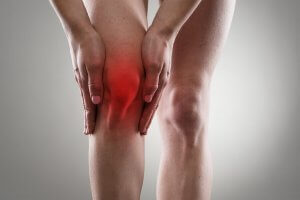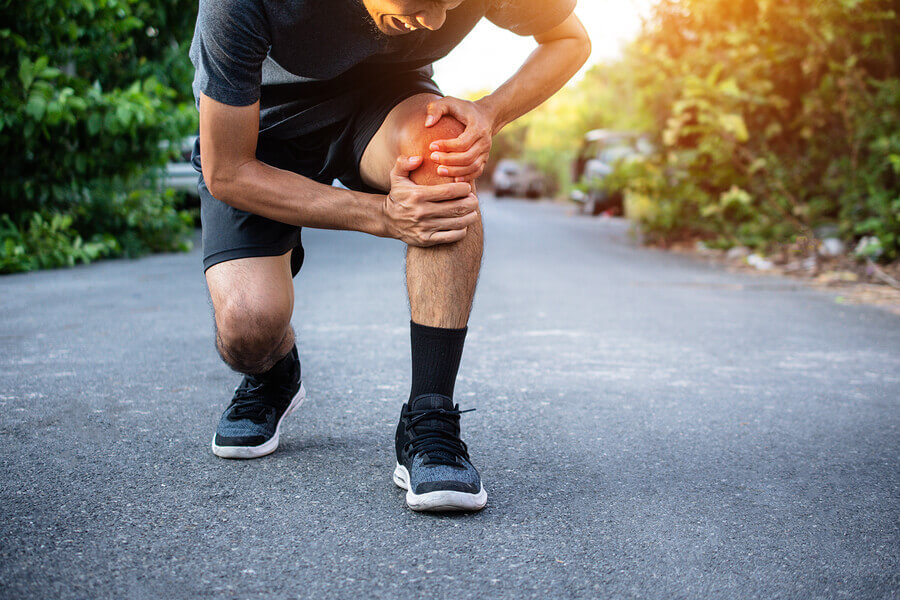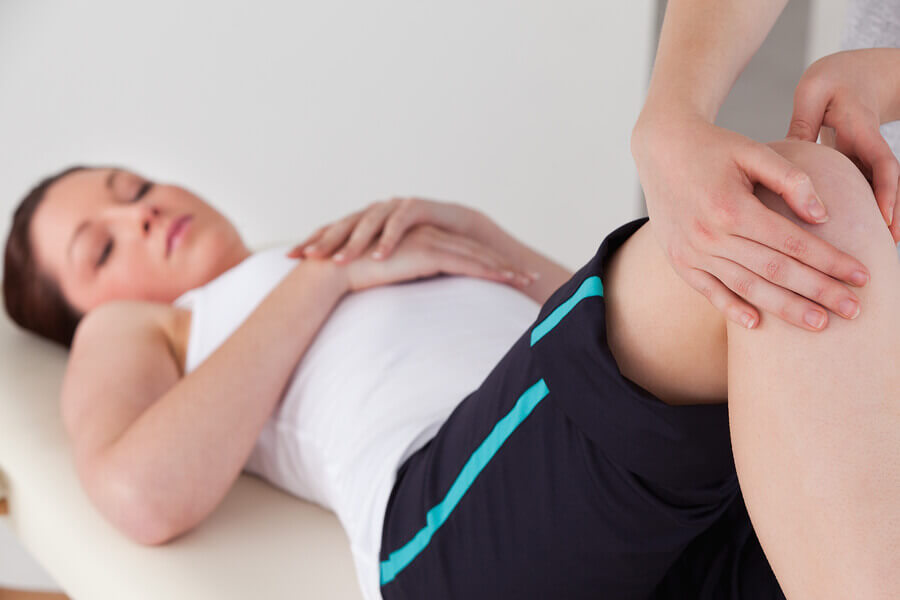Patellar Tendinitis: Causes, Symptoms and Treatments

The condition referred to as patellar tendinitis also has other names. Some people know it as patellar tendinopathy or jumper’s knee.
It consists of an inflammation of the patellar tendon, which connects the patella with the tibia. This tendon tissue extends over the knee bone and part of the quadriceps muscle and then attaches to the largest bone in the leg, which is the tibia.
It’s an important, thick tendon with a lot of force overload since it must direct much of the movements of the lower limbs. Therefore, sports activities that are too demanding or repetitive may cause injuries in that area.
The sudden movements that are most associated with patellar tendinitis are jumps, falls, and changing the direction while running. Hence, this condition mostly affects athletes that practice sports such as high and long jumps, basketball, volleyball, and soccer.
The greater the knee strain is, the higher the chance of experiencing a tear, strain, or inflammation of this tendon will be as well. There’s a tendency to think that this isn’t a serious injury, but it can actually have important consequences.
Because of this, athletes who suffer from this condition shouldn’t practice their sport of choice while the injury hasn’t healed. Some specific cases may even require surgery to repair it.
Causes of patellar tendinitis
Patellar tendinitis happens due to an overload of the patellar tendon. The intrinsic mechanisms that explain the injury are the micro-traumas that sports practice can exert on the knee, especially when jumping. While it’s possible to prevent this injury by improving our running and jumping technique, small traumas always happen.
Experts have also confirmed that not stretching and relaxing the muscles properly after intense exercise can contribute to this condition. Even wearing inappropriate footwear could lead to tendinitis.
The way we step is closely linked to the axis that our lower limbs should have, and this includes the knees. Footwear also plays a very important role in shock absorption when jumping and falling.

A less frequent origin of patellar tendinitis is a congenital deviation of the patella. A specialist can detect this deviation before the injury, or we can discover it when we’ve already suffered some damage.
Symptoms
The jumper’s knee manifests itself with:
- Knee pain: this is the main sign. It hurts above the patellar tendon, below the kneecap, right at the knee level.
- Stiffness: the patient may experience a feeling of having their knee ‘locked’; they’re unable to flex it properly. For example, it’s very hard to climb a ladder, sit, or get up.
- Muscle pain: even though it’s tendinopathy, the quadriceps may suffer pain due to the proximity they have with the damaged area and the solidarity with the mechanisms of injury. It’s a pain that can be quite intense, located in the large muscle of the front of the thigh.
- Lack of strength: the lower limbs feel weak.
There are also some less frequent symptoms that may or may not be present:
- Imbalance: some athletes notice that they aren’t stable when they have patellar tendinitis. It’s as if they lose their balance when walking.
- Heat: you can feel your knee getting very hot.
- Edema: if the knee accumulates liquid, it increases its size compared to the other knee.
Jumper’s knee treatment
With mild patellar tendonitis, it’s possible to use conservative treatments. We would mostly require rest and suspension of sports activities for a certain time, for as long as our doctor indicates.
Along with this, it’s also important to apply cold packs to the knee and maybe take anti-inflammatory drugs. One of the most widely used medications for this is ibuprofen.
The patient will need physical therapy rehabilitation to return to their sports practice. Along with manipulation by a professional, we can use special elastic bands designed for these cases. You place them under the kneecap to provide stability and fixation to the tendon.
A month of rehabilitation is usually enough, but sometimes the treatment must be longer. The treating team must define what is best for each clinical situation.

On the other hand, if the injury is serious, there’s the possibility of surgery. The intervention is performed by arthroscopy, with minimal invasion of the joint. The doctor will remove damaged tendon tissue and perform a decompression to release the accumulating tension. This type of surgery usually requires a recovery period of over a month, and physical therapy must follow a strict schedule.
Prevention of patellar tendinitis
It’s important to train with the prevention of patellar tendinitis in mind. Athletes at higher risk should especially strengthen the surrounding muscles to provide stability to the joint.
If we experience any pain, it’s best to stop the practice. There’s no point in forcing any part of the body at risk of increasing the negative consequences. On top of that, besides resting, you can apply cold packs locally when you feel the pain to counteract the inflammation.
Finally, a good recommendation is to perfect the techniques you use for your sport of choice. Improving our method of running, jumping, braking, and changing direction are in the best interest of our bodies. It’s important to contact experts in the sport we practice so they teach and give us advice.
The condition referred to as patellar tendinitis also has other names. Some people know it as patellar tendinopathy or jumper’s knee.
It consists of an inflammation of the patellar tendon, which connects the patella with the tibia. This tendon tissue extends over the knee bone and part of the quadriceps muscle and then attaches to the largest bone in the leg, which is the tibia.
It’s an important, thick tendon with a lot of force overload since it must direct much of the movements of the lower limbs. Therefore, sports activities that are too demanding or repetitive may cause injuries in that area.
The sudden movements that are most associated with patellar tendinitis are jumps, falls, and changing the direction while running. Hence, this condition mostly affects athletes that practice sports such as high and long jumps, basketball, volleyball, and soccer.
The greater the knee strain is, the higher the chance of experiencing a tear, strain, or inflammation of this tendon will be as well. There’s a tendency to think that this isn’t a serious injury, but it can actually have important consequences.
Because of this, athletes who suffer from this condition shouldn’t practice their sport of choice while the injury hasn’t healed. Some specific cases may even require surgery to repair it.
Causes of patellar tendinitis
Patellar tendinitis happens due to an overload of the patellar tendon. The intrinsic mechanisms that explain the injury are the micro-traumas that sports practice can exert on the knee, especially when jumping. While it’s possible to prevent this injury by improving our running and jumping technique, small traumas always happen.
Experts have also confirmed that not stretching and relaxing the muscles properly after intense exercise can contribute to this condition. Even wearing inappropriate footwear could lead to tendinitis.
The way we step is closely linked to the axis that our lower limbs should have, and this includes the knees. Footwear also plays a very important role in shock absorption when jumping and falling.

A less frequent origin of patellar tendinitis is a congenital deviation of the patella. A specialist can detect this deviation before the injury, or we can discover it when we’ve already suffered some damage.
Symptoms
The jumper’s knee manifests itself with:
- Knee pain: this is the main sign. It hurts above the patellar tendon, below the kneecap, right at the knee level.
- Stiffness: the patient may experience a feeling of having their knee ‘locked’; they’re unable to flex it properly. For example, it’s very hard to climb a ladder, sit, or get up.
- Muscle pain: even though it’s tendinopathy, the quadriceps may suffer pain due to the proximity they have with the damaged area and the solidarity with the mechanisms of injury. It’s a pain that can be quite intense, located in the large muscle of the front of the thigh.
- Lack of strength: the lower limbs feel weak.
There are also some less frequent symptoms that may or may not be present:
- Imbalance: some athletes notice that they aren’t stable when they have patellar tendinitis. It’s as if they lose their balance when walking.
- Heat: you can feel your knee getting very hot.
- Edema: if the knee accumulates liquid, it increases its size compared to the other knee.
Jumper’s knee treatment
With mild patellar tendonitis, it’s possible to use conservative treatments. We would mostly require rest and suspension of sports activities for a certain time, for as long as our doctor indicates.
Along with this, it’s also important to apply cold packs to the knee and maybe take anti-inflammatory drugs. One of the most widely used medications for this is ibuprofen.
The patient will need physical therapy rehabilitation to return to their sports practice. Along with manipulation by a professional, we can use special elastic bands designed for these cases. You place them under the kneecap to provide stability and fixation to the tendon.
A month of rehabilitation is usually enough, but sometimes the treatment must be longer. The treating team must define what is best for each clinical situation.

On the other hand, if the injury is serious, there’s the possibility of surgery. The intervention is performed by arthroscopy, with minimal invasion of the joint. The doctor will remove damaged tendon tissue and perform a decompression to release the accumulating tension. This type of surgery usually requires a recovery period of over a month, and physical therapy must follow a strict schedule.
Prevention of patellar tendinitis
It’s important to train with the prevention of patellar tendinitis in mind. Athletes at higher risk should especially strengthen the surrounding muscles to provide stability to the joint.
If we experience any pain, it’s best to stop the practice. There’s no point in forcing any part of the body at risk of increasing the negative consequences. On top of that, besides resting, you can apply cold packs locally when you feel the pain to counteract the inflammation.
Finally, a good recommendation is to perfect the techniques you use for your sport of choice. Improving our method of running, jumping, braking, and changing direction are in the best interest of our bodies. It’s important to contact experts in the sport we practice so they teach and give us advice.
All cited sources were thoroughly reviewed by our team to ensure their quality, reliability, currency, and validity. The bibliography of this article was considered reliable and of academic or scientific accuracy.
- Sánchez, S. Hernández, et al. “Mitos y realidades en la tendinopatía rotuliana del deportista. Abordaje desde la evidencia científica.” Fisioterapia 31.6 (2009): 255-261.
- Bonilla Ugalde, Priscilla, Melany Chavarria Briceño, and Cesia Grajales Navarrete. “Tendinitis rotuliana (rodilla del saltador)”. Revista Médica de Costa Rica y Centroamérica 73.620 (2016): 519-523.
- Yerga-Rodríguez, Eduardo. “Tratamiento de la tendinopatía rotuliana.” (2014).
This text is provided for informational purposes only and does not replace consultation with a professional. If in doubt, consult your specialist.








